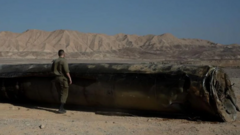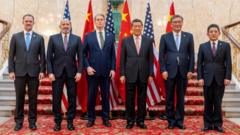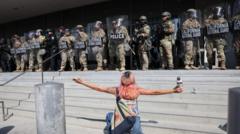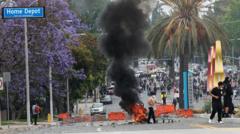The proposed Golden Dome aims to enhance U.S. missile defense capabilities in the face of advanced threats from rival nations. Experts warn of significant challenges related to cost, logistics, and the potential for an arms race as the project unfolds.**
The Golden Dome: Trump's Ambitious Plan for a U.S. Missile Defense System**
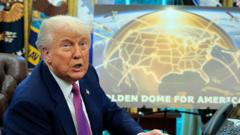
The Golden Dome: Trump's Ambitious Plan for a U.S. Missile Defense System**
In response to growing global missile threats, President Trump outlines a bold vision for a multi-layered missile defense system, dubbed the Golden Dome, amid skepticism over its feasibility and cost.**
The proposed Golden Dome missile defense system, championed by President Donald Trump, reflects today's pressing concerns over national security. As threats of sophisticated missile technologies emerge from adversaries like Russia and China, Trump sees the development of this next-generation shield as essential for safeguarding the U.S. from potential catastrophe.
The Golden Dome, initially referred to as the "Iron Dome for America," seeks to address the evolving landscape of global warfare, characterized by advanced capabilities such as hypersonic missiles and orbital bombardment systems. Experts warn that a successful high-tech attack could lead to devastating consequences, including a large-scale electromagnetic pulse (EMP) that would cripple essential infrastructure nationwide.
While military officials tout the necessity of the Golden Dome, they acknowledge the formidable challenges ahead. Both logistical and financial barriers may hinder progress, as the estimated costs soar to hundreds of billions of dollars—far overshooting initial projections. The Congressional Research Office suggests that a minimal defense would require numerous space-based platforms, which further complicates the ambitious timeline Trump has proposed for completion before the end of his term.
A key aspect of the Golden Dome lies in its envisioned capability to detect and intercept threats across diverse domains: land, sea, and space. During a recent statement, Trump emphasized the system's potential to neutralize missiles even from long distances and outer space. However, it remains unclear what the final architecture of the system will look like, as specifics are still largely undeveloped. Defense Secretary Pete Hegseth mentioned that multiple layers of protection would be integrated, yet the current systems mainly focus on traditional intercontinental ballistic missiles (ICBMs).
Despite the urgent call for an advanced missile defense program, many analysts express skepticism regarding its feasibility. The existing U.S. defense systems were primarily designed to counter threats from nations like North Korea, not the expansive arsenals possessed by other global powers. As a result, experts argue that current setups would be ineffective against a larger missile attack from countries like China or Russia.
The Golden Dome's announcement has also sparked concerns that it might catalyze a new arms race, with adversaries rapidly advancing their offensive capabilities to outsmart enhanced American defenses. Critics have pointed out that merely bolstering U.S. missile defense could provoke further instability in global military dynamics.
Nevertheless, proponents such as missile defense expert Patrycja Bazylczyk view the Golden Dome as a necessary deterrent that could alter the strategic calculations of potential aggressors. “It contributes to overall deterrence,” Bazylczyk stated, emphasizing that even partial implementation of the defense system could significantly enhance national security.
As the Golden Dome continues its conceptual journey toward realization, the challenges surrounding its effectiveness, logistics, and financial implications leave many experts cautious about its ultimate success. “We need that type of system,” says author William Fortschen, expressing optimism that the initiative, if executed properly, could prevent catastrophic outcomes for the nation. As discussions unfold, the fate of the Golden Dome remains uncertain amidst the complexities of modern-day defense strategies.











